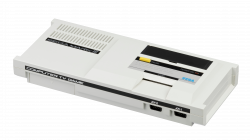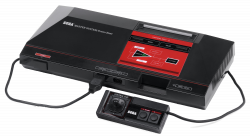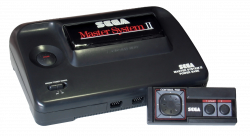Master System:Master System Model Differences: Difference between revisions
| Line 55: | Line 55: | ||
=== Master System II (1990-1993) === | === Master System II (1990-1993) === | ||
[[Image:SMSII.png|thumb|right|250px|The Sega Master System II. This | [[Image:SMSII.png|thumb|right|250px|The Sega Master System II. This two-tone color scheme only appeared in North America, Australia and France.]] | ||
[[Image:PAL Master System II.png|thumb|right|250px|A typical PAL Master System II, featuring a black color scheme.]] | |||
A cost-conserving slimmed down version of the Master System, released in 1990 in North America and 1991 for PAL regions. Noticeably smaller than the original, this version lacks the card slot (meaning no 3-D glasses support), expansion port, composite out, and reset button (French Master System IIs still possess RGB output, albeit unamplified). The cartridge port is also hidden behind a clear plastic sliding door displaying the console name, which cannot be closed with a cartridge inserted. Most PAL models feature an all-black color scheme while all NTSC and some Australian and French consoles have a light gray top half with a white pause button. | A cost-conserving slimmed down version of the Master System, released in 1990 in North America and 1991 for PAL regions. Noticeably smaller than the original, this version lacks the card slot (meaning no 3-D glasses support), expansion port, composite out, and reset button (French Master System IIs still possess RGB output, albeit unamplified). The cartridge port is also hidden behind a clear plastic sliding door displaying the console name, which cannot be closed with a cartridge inserted. Most PAL models feature an all-black color scheme while all NTSC and some Australian and French consoles have a light gray top half with a white pause button. | ||
Revision as of 17:24, 31 October 2023
Some page content & researching partially taken from io55.net's Sega Master System page with permission, in collaboration.
There are four Master System models, with several revisions for the international Master System models.
Models
Models are arranged chronologically.
Mark III (1985-1987)
This is the original release of the Master System hardware, released in Japan on October 20, 1985. The Mark III cosmetically resembles its predecessor, the SG-1000 II, and is roughly the same size as that earlier console. Located on the left-hand side is an expansion port carried over from the SG-1000 line, used to connect the SK-1100 keyboard and the later FM Sound Unit (note that this expansion port is not the same used on later international consoles). Two controller ports are located on the right-hand side (which are numbered in opposite order compared to other consoles) as well as a built-in card slot for reading games on the Sega Card/My Card format. On the back are the power switch, RF out and AV out. The Mark III is also backwards compatible with SG-1000 games, but the color palette is vastly different compared to an original SG-1000 console and may make playing certain games difficult.
Internally the Mark III is fairly similar in construction to its predecessors, featuring a single-sided motherboard and even some of the same parts (e.g. the power switch and leaf switch for the pause button). The Mark III was also the first Sega console to possess RGB output, but it is unamplified and requires external circuitry or modification to make it suitable for most displays. Sega did not sell an official RGB cable in Japan or even acknowledge the fact that it featured RGB output.
Only one board revision, the 171-5304, exists for the Mark III and all consoles were manufactured in Japan.
Master System (1986-1991)
The original release of the Master System hardware for the rest of the world. Although largely internally identical to the Mark III, the Master System is vastly different cosmetically, featuring a black and red color scheme, and is larger than the Mark III. Located on the front are the power switch, controller ports and Sega Card slot. The international Master System also has amplified RGB output and a different expansion port, which never saw use. Sega also changed the cartridge port and shape for the West, so Japanese cartridges and SG-1000 games are not compatible.
Sega put out several revisions of the original Master System over its life, most of which had different built-in games and differing internal construction.
171-5379/837-6067 (1986-1987, NTSC)
This is the original NTSC revision of the Master System and was made available in two different bundles, known as the "Base System" and "Master System". The "Base System" featured the console with two controllers and a Hang-On/Astro Warrior combo cartridge, while the "Master System" added the Light Phaser light gun and Hang-On/Safari Hunt as the pack-in game. This revision has the v1.3 BIOS, which displays instructions on how to insert a game when the console is turned on without a game inserted. However, by pressing Up plus both buttons on the controller, a secret Snail Maze game is revealed. Once the player runs out of time to complete a maze, the console resets.
PCB quality on the 171-5379 is relatively high and it has double-sided solder joints, making it more reliable compared to most other model 1 SMS revisions. This revision also uses the Sony V7040 video encoder, which produces decent composite video. The 7805 voltage regulator is mounted on a massive heat sink, but unusually the regulator is mounted inward, complicating repairs and modifications as it must be either desoldered with the heat sink still attached, or unscrewed first using a very long screwdriver.
Consoles with this board revision were manufactured in either Japan or Taiwan, and have a serial number with "6" as the second digit.
837-6097 (1987, PAL)
The original PAL revision of the Master System. It is mostly identical to the 837-6067 board, except that a portion of the audio/video circuitry is underneath a small RF shield in order to reduce interference. In addition, the 7805 regulator was flipped around to face outward, making repairs much simpler. At some point during production, the V7040 encoder was replaced with a Sony CXA1145 and the leaf switches for the Pause and Reset buttons were replaced with rubber dome switches to reduce cost. Both versions of this board also used the v1.3 BIOS.
837-6405/837-6629 (1987-1990, NTSC)
These revisions are perhaps the most common for the NTSC SMS, and appeared at around the same time Sega of America handed off distribution of the Master System to Tonka. Both these boards are mostly identical, with the main difference being the BIOS. The 837-6405 still used the v1.3 BIOS and came bundled with a combo cartridge, but the 837-6629 incorporated a built-in game depending on the bundle. The "Base System" featured Hang-On (BIOS v3.4), the "Master System" Hang-On/Safari Hunt (BIOS v2.4), and the "SegaScope 3D" bundle Missile Defense 3-D (BIOS v4.4).
However, these revisions suffer from reduced build quality compared to the original SMS, which is especially apparent with the motherboard. While the board itself is still double-sided, the solder joints are not, being only plated through on the underside. This can lead to the solder joints for the cartridge and card ports developing cracks, usually causing the console to display a "Software Error" message when a game is inserted. The outer ground plane is also bare copper and not HASL plated, meaning it can corrode fairly easily. Sega also replaced the V7040 video encoder with the CXA1145, which would later see use in the Genesis/Mega Drive. However, Sega's implementation of the CXA1145 was not well-executed and composite video is subpar compared to the V7040. Sega also swapped out the leaf switches for Pause and Reset with rubber dome switches.
Some French Master Systems use the 837-6629 board (despite it being designed for NTSC systems), but with the CXA1145 and all of its supporting circuitry removed and the VDP set for 50 Hz instead of 60. The RGB signals from the VDP are instead output directly from the console and into a SCART cable which includes an RGB amplifier. Later French Master Systems manufactured in late 1990 also have Alex Kidd in Miracle World as the built-in game.
VA2 (1988-1989, PAL)
Only used in PAL regions, this was the first SMS board revision to use Sega's "VA" naming scheme. It is similar to the 837-6629, but still has its solder joints plated on both sides and still has HASL plating on the ground plane. Two variants of the VA2 exist, the 837-6424 and 837-6473. The only main difference is the built-in game, with the former having Hang-On and the latter having Hang-On/Safari Hunt.
VA3 (1989-1991, PAL)
This was the final revision for the model 1 SMS, and like the VA2 before it, was only used in PAL consoles. This was a rather major revision as Sega began using the revised 315-5246 VDP (which came in an unusual QIP package) and 315-5237 I/O chip, both of which were later used in the Master System II. The built-in game was either Hang-On or Hang-On/Safari Hunt depending on the bundle, while VA3s manufactured in 1990 and 1991 featured Alex Kidd in Miracle World instead.
SECAM model (1990)
An extremely rare model which appears to have only been sold in the Soviet Union. It is by far the most unusual of the model 1 variants, and is the only Master System which outputs SECAM video. Internally it very closely resembles the later Master System II, as it lacks a card slot, expansion port, reset button, and only has RF output (the footprint for an 8-pin DIN connector is present but is unused).
Master System (MK-2000, Japan) (1987-1988)
For the Japanese market in late 1987, Sega replaced the Mark III with a revised version of the international Master System with extra hardware features. It very closely resembles its international counterpart, but does have some crucial differences. The FM Sound Unit, 3-D glasses adapter and Rapid Fire Unit are all built-in to this console, adding extra value; these were all optional accessories for the Mark III. It still uses the same cartridges as the Mark III and is also backwards compatible with SG-1000 games. This console also has a very distinctive BIOS which plays a rendition of the Space Harrier theme (using both FM and PSG sound) when no game is inserted.
Internally, the MK-2000 is very similar in build quality to later NTSC Master Systems, including the use of single-sided solder joints, rubber dome switches and the CXA1145 video encoder. Unlike international Master Systems, the RGB signals have 75 ohm in-line resistors, which will result in a darker picture if a standard Master System/Genesis RGB cable is used. Sega also eschewed an internal RF modulator, opting for an external unit instead. All MK-2000s use the 837-6418 board revision and were manufactured in either Japan or Taiwan.
Master System II (1990-1993)
A cost-conserving slimmed down version of the Master System, released in 1990 in North America and 1991 for PAL regions. Noticeably smaller than the original, this version lacks the card slot (meaning no 3-D glasses support), expansion port, composite out, and reset button (French Master System IIs still possess RGB output, albeit unamplified). The cartridge port is also hidden behind a clear plastic sliding door displaying the console name, which cannot be closed with a cartridge inserted. Most PAL models feature an all-black color scheme while all NTSC and some Australian and French consoles have a light gray top half with a white pause button.
VA1 (1990-1993, NTSC and France)
This is the original board revision of the Master System II and is only found in North American and French consoles. Alex Kidd in Miracle World is the built-in game, and the BIOS also displays a simple Sega logo on startup in place of the original animated startup sequence. While it uses the revised 315-5246 VDP like the VA3 model 1, it still uses the original 315-5216 I/O chip instead of the newer 315-5237. The board layout and component footprints are identical between French and North American consoles, but both have some significant component differences. North American SMS IIs run at 60 Hz and only have RF out, while French models run at 50 Hz, have no video encoder, and have unamplified RGB output via the same 8-pin DIN connector as the model 1.
The North American SMS II was only manufactured for a short time in 1990 and was quickly discontinued due to the Master System's fading presence in that market, while the French SMS II continued on until at least 1993. All NTSC models were manufactured in Japan while French models were mainly manufactured in China.
M4Jr. PAL (1991-1992)
The original SMS II revision for PAL regions. It is largely based on the VA1 board with some changes, the most significant being the use of the 315-5237 I/O chip as used in the VA3 model. Alex Kidd in Miracle World is the built-in game as before.
M4Jr. PAL 2M (1992-1993)
Appearing towards the end of 1992 for PAL regions only, this is the final revision of the Master System II. The "2M" in the board revision name refers to the two megabit (256 kilobyte) BIOS ROM, which now features Sonic the Hedgehog as the built-in game. In addition, the CXA1145 encoder was replaced with the pin-compatible Fujitsu MB3514. Aside from the BIOS and video encoder, it is functionally identical to the earlier M4Jr. PAL revision.
References
https://en.wikipedia.org/wiki/Master_System
https://en-academic.com/dic.nsf/enwiki/5908108
https://gametrog.com/sega-master-system-information-specs/
https://segaretro.org/Master_System_consoles_in_North_America
https://www.smspower.org/Development/HardwareImages-Index
https://gametrog.com/sega-powerbase-converter-information-specs/



